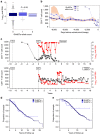Identification of Siglec-1 null individuals infected with HIV-1
- PMID: 27510803
- PMCID: PMC4987525
- DOI: 10.1038/ncomms12412
Identification of Siglec-1 null individuals infected with HIV-1
Abstract
Siglec-1/CD169 is a myeloid-cell surface receptor critical for HIV-1 capture and infection of bystander target cells. To dissect the role of SIGLEC1 in natura, we scan a large population genetic database and identify a loss-of-function variant (Glu88Ter) that is found in ∼1% of healthy people. Exome analysis and direct genotyping of 4,233 HIV-1-infected individuals reveals two Glu88Ter homozygous and 97 heterozygous subjects, allowing the analysis of ex vivo and in vivo consequences of SIGLEC1 loss-of-function. Cells from these individuals are functionally null or haploinsufficient for Siglec-1 activity in HIV-1 capture and trans-infection ex vivo. However, Siglec-1 protein truncation does not have a measurable impact on HIV-1 acquisition or AIDS outcomes in vivo. This result contrasts with the known in vitro functional role of Siglec-1 in HIV-1 trans-infection. Thus, it provides evidence that the classical HIV-1 infectious routes may compensate for the lack of Siglec-1 in fuelling HIV-1 dissemination within infected individuals.
Figures



References
-
- Cameron P. U. et al. Dendritic cells exposed to human immunodeficiency virus type-1 transmit a vigorous cytopathic infection to CD4+ T cells. Science 257, 383–387 (1992). - PubMed
-
- Geijtenbeek T. B. et al. DC-SIGN, a dendritic cell-specific HIV-1-binding protein that enhances trans-infection of T cells. Cell 100, 587–597 (2000). - PubMed
Publication types
MeSH terms
Substances
Grants and funding
LinkOut - more resources
Full Text Sources
Other Literature Sources
Medical

